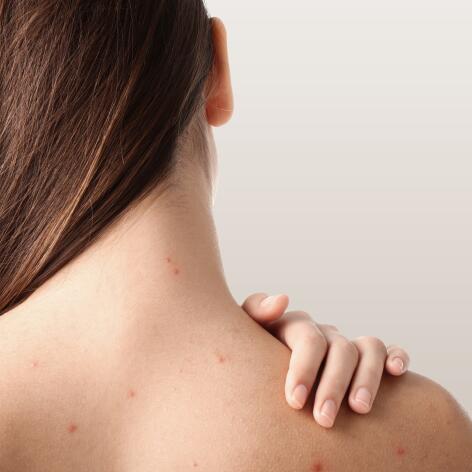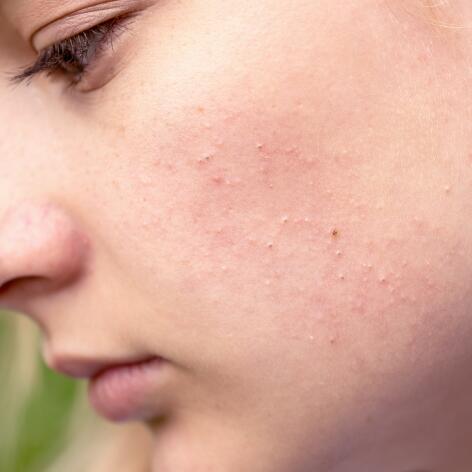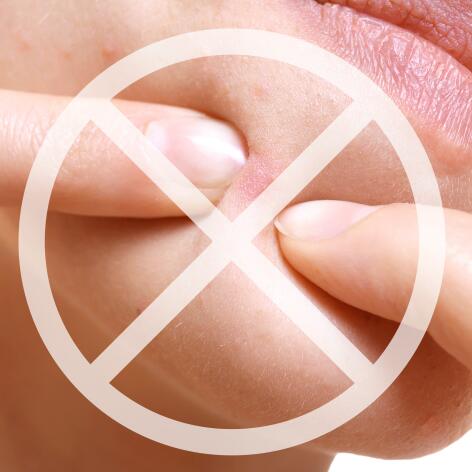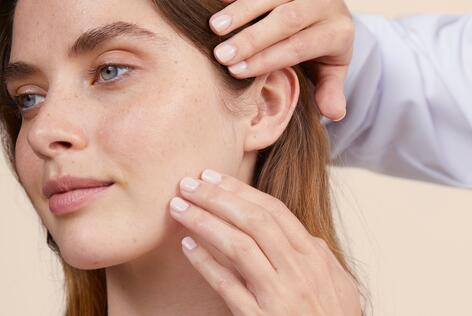Hormonal acne
Hormonal acne first appears in puberty (85% of teenage Australians are affected*) and can recur or break out in adulthood, especially in women. Women between the ages of 20 and 45 years old are affected by acne**.
What is hormonal acne?
For girls and boys alike, acne usually starts in puberty. The cause is hormonal upheaval, which causes the skin to produce more sebum. It can be difficult for sebum to flow through the pores: the small holes that drain it away. The skin then becomes oily and acne can appear on the face, back, shoulders, neckline, etc.
Hormonal acne usually disappears after adolescence. But sometimes it persists, returns or is triggered in adulthood. Hormonal acne is less talked about, and yet a quarter of adults are affected by it, the vast majority of whom are women.

What are the different stages of hormonal acne?
There is not one but several types of acne, which can come one after the other or present at the same time.
The prerequisite for acne in adolescence is hyperseborrhea, when the skin produces too much sebum due to hormonal changes. At this stage, the skin is simply oily.
Under the skin, a microcomedo can start to form, where the excess sebum thickens and changes into a kind of horn that clogs the pore. Invisible at first, it then becomes a comedo which will first be open (a whitehead) and under the effect of the oxidation of the sebum in contact with the air, it becomes black (a blackhead). This is called retentional acne.
If left untreated, the next step is inflammatory acne. This is the result of the infection of a pimple by the proliferation of the bacterium Cutibacterium Acnes. These blemishes take the form of papules (large, hard, red pimples), sometimes topped by pustules (containing a purulent liquid).

I've noticed that if I don't clean my skin regularly every day, then I always get pimples that come back, and I can't do anything about it, and then it's too late. It especially happens the week before my period.
Hormonal acne for men and women
Hormonal acne affects men and women, but not at the same time or in the same areas.
Hormonal acne in women
Periods, pregnancy, menopause... Female hormonal activity fluctuates for a long time, and this is a major reason why hormonal acne persists. Pimples tend to be inflammatory and often appear just before a woman's period, especially on the lower face (around the chin and jaw).
Hormonal acne in men
Although men are not spared from hormonal acne in puberty, their skin problems generally regress and disappear in adulthood once their hormones have stabilised. When pimples persist, they are mostly located on the back and neck.
FRIENDLY, EXPERT ADVICE
Some treatments that are prescribed to treat hormonal acne irritate and dry out the skin. The skin therefore needs to be rebalanced.
The downfall of some topical treatments for hormonal acne is that they strip the skin. The skin therefore needs appropriate care to make up for this. This starts with gentle cleansing and make-up removal using a soap-free cleanser. Thermal Spring Water with soothing properties can also be sprayed on the face. Cleared of tap water residues, the skin is ready to receive a soothing moisturiser that will restore skin comfort.
The right things to do to soothe hormonal acne
Gentle, gentle, gentle is your mantra! This is how you can create the conditions to (finally!) get rid of your hormonal acne, whether you’re a teenager or adult. A gentle approach is achieved through developing good skin care habits (don't rub cotton pads too hard against the skin, and don't pop your pimples), as well as through the choice of products you apply to the skin. The words "non-comedogenic" or "acne-prone skin" will help guide you.

Our solutions for hormonal acne
Eau Thermale Avène skincare products are designed to make peace you with your skin
NEWSLETTER
We're always here for your skin!
All our advice on how to take care of your skin day to day.

* Skin Health Institute - Acne
** Survey conducted in 2021 by Pierre Fabre Dermatology Laboratoires in CS Sante, on 10,000 subjects in France.
Which skin care routine should you adopt?
Identify what it really needs with the help of our experts and discover the most suitable skin care routine for you.

